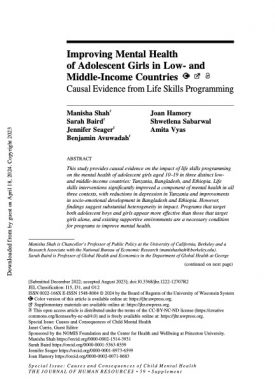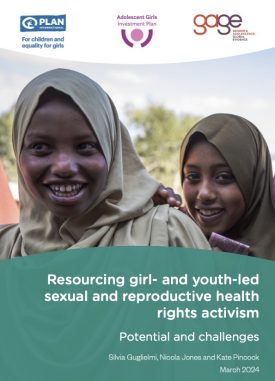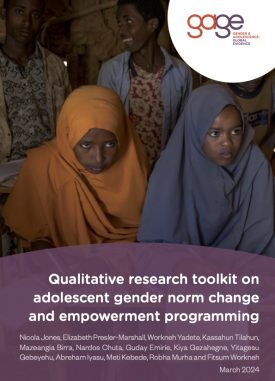Until recently, global public health initiatives have tended to overlook the ways that social factors shape adolescent health, and particularly how these dynamics affect the specific needs of adolescents in relation to information about puberty, menstruation and sexual health. This article draws on mixed methods data from rural and urban areas of Ethiopia to explore how access to health information and resources – and subsequently health outcomes – for adolescents are mediated by gender and age norms, living in different geographical locations, poverty, disability and migration.
Data was collected in 2017–2018 for the Gender and Adolescence: Global Evidence (GAGE) mixedmethods longitudinal research baseline in three regions of Ethiopia (Afar, Amhara and Oromia). Quantitative data was collected from over 6800 adolescents and their caregivers, with qualitative data obtained from a sub-sample of 220 adolescents, their families and communities.
Analysis suggested that gender inequality intersects with age, disability and rural/urban differences to shape young people’s access to information about puberty, with knowledge about this topic particularly lacking amongst younger adolescents in rural areas. Drought and lack of access to clean water exacerbates health challenges for adolescents in rural areas, where a lack of information and absence of access to preventive healthcare services can lead to permanent disability. The research also found that gaps in both school-based and alternative sources of education about puberty and menstruation reinforce stigma and misinformation, especially in rural areas where adolescents have higher school attrition rates. Gendered cultural norms that place high value on marriage and motherhood generate barriers to contraceptive use, particularly in certain rural communities.
Suggested citation
Jones, N., Pincock, K., Baird, S., Yadete, W. and Hamory Hicks, J. (2020) ‘Intersecting inequalities, gender and adolescent health in Ethiopia.’ International Journal for Equity in Health, 19: 97, (https://doi.org/10.1186/s12939-020-01214-3)


